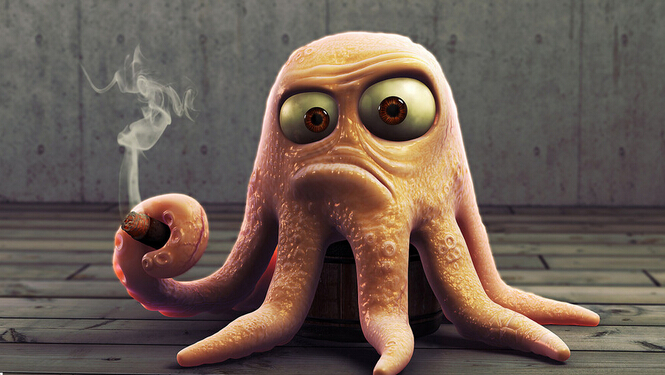(单词翻译:单击)

Researchers observed the behavior of amputated octopus arms, which remain very active for an hour after separation. Those observations showed that the arms never grabbed octopus skin, though they would grab a skinned octopus arm. The octopus arms didn’t grab Petri dishes covered with octopus skin, either, and they attached to dishes covered with octopus skin extract with much less force than they otherwise would.
在截断章鱼的腕足后,研究人员观察发现断肢在离体一小时后仍相当有活力。断肢离体后的行为观察显示,断肢不会吸附章鱼皮肤,但是会吸附剥了皮的章鱼腕足;断肢也不会吸附覆盖着章鱼皮的培养皿。在吸附涂有章鱼皮肤提取物的培养皿时,会比吸附空培养皿时使用更小的力量。一只章鱼的八条腕足上密布着成百上千个吸盘,会吸附几乎任何东西,但有一个重要的例外。这些吸盘一般不会吸附章鱼自身;否则,这只极其灵活的动物很快就会发现自己整个纠缠在了一起。
Now, researchers from the Hebrew University of Jerusalem report in the Cell Press publication Current Biology on May 15 that they have discovered how octopuses manage this feat, even as the octopuses’ brains are unaware of what their arms are doing. A chemical produced by octopus skin temporarily prevents their suckers from sucking.
现在,耶路撒冷希伯来大学的研究人员于5月15日在细胞期刊数据库(Cell Press [i])的期刊《现代生物》(Current Biology)上发表了他们的研究成果,并称他们已发现章鱼实现这一壮举的原理,甚至是章鱼的大脑不知情的情况下完成这一行为。一种由章鱼皮肤产生的化学物质能够在短期内阻止其吸盘的吸附行为。
“We were surprised that nobody before us had noticed this very robust and easy-to-detect phenomena,” says Guy Levy, who carried out the research with co-first author Nir Nesher. “We were entirely surprised by the brilliant and simple solution of the octopus to this potentially very complicated problem.”
“这个现象非常强大且易于检测,在我们之前竟无人注意到这一点,我们感到很惊讶,”与共同第一作者尼尔-内舍(Nir Nesher)一同进行了研究后,盖伊-列维(Guy Levy)说。“更让我们惊讶的是章鱼精彩而又简单地解决了这本会非常复杂的问题。”
Binyamin Hochner and his colleagues had been working with octopuses for many years, focusing especially on their flexible arms and body motor control. There is a very good reason that octopuses don’t know where their arms are exactly, in the same way that people or other animals do.
本雅明-霍齐纳(Binyamin Hochner)和他的同事研究章鱼多年,尤其是关注他们灵活的腕足和身体运动的控制。他们发现,章鱼并不能像人与其他动物一样知道自己腕足的确切位置。
“Our motor control system is based on a rather fixed representation of the motor and sensory systems in the brain in a formant of maps that have body part coordinates,” Hochner explains.
“我们人类大脑中的感觉系统有分别对应特定身体部位的区域,而运动控制系统则是一个相对固定的感觉系统对动作的映射,”霍齐纳解释道。
That works for us because our rigid skeletons limit the number of possibilities. “It is hard to envisage similar mechanisms to function in the octopus brain because its very long and flexible arms have an infinite number of degrees of freedom,” Hochner continues. “Therefore, using such maps would have been tremendously difficult for the octopus, and maybe even impossible.”
这对于我们来说是适用的,因为我们僵硬的骨架限制了我们活动。“在章鱼大脑中也使用与之相似的机制是难以想象的,因为它那长而灵活的腕足可以进行各种角度的运动,”霍齐纳继续说道,“因此,如果章鱼大脑中也用相似的区域分布来控制运动,会是相当困难的,甚至是不可能的。”
Indeed, experiments have supported the notion that octopuses lack accurate knowledge about the position of their arms. And that raised an intriguing question: How, then, do octopuses avoid tying themselves up in knots?
事实上,实验结果表明章鱼确实并不能掌握其腕足确切位置。这样的结果也引出了一个有趣的问题:那么,章鱼是怎样避免把自己缠成一团乱麻的呢?
To answer that question, the researchers observed the behavior of amputated octopus arms, which remain very active for an hour after separation. Those observations showed that the arms never grabbed octopus skin, though they would grab a skinned octopus arm. The octopus arms didn’t grab Petri dishes covered with octopus skin, either, and they attached to dishes covered with octopus skin extract with much less force than they otherwise would.
为了找到答案,研究人员将章鱼腕足截取下来,观察其行为,这些腕足在离体一小时后仍然相当有活力。最终观察结果显示,腕足断肢不会吸附章鱼皮,但是会吸附剥了皮的章鱼腕足;不会吸附覆盖着章鱼皮的培养皿,但是在吸附涂有章鱼皮肤提取物的培养皿时,会比吸附空培养皿时使用更小的力量。
“The results so far show, and for the first time, that the skin of the octopus prevents octopus arms from attaching to each other or to themselves in a reflexive manner,” the researchers write. “The drastic reduction in the response to the skin crude extract suggests that a specific chemical signal in the skin mediates the inhibition of sucker grabbing.”
“目前为止,研究有了新发现:章鱼皮肤能够防止腕足间相互吸附或腕足吸附自身,”研究人员这样写道。“对皮肤粗提取物的反应急剧减弱说明皮肤中存在一种特定的化学信号,这种化学信号会调解对吸盘吸附的抑制作用。”
In contrast to the behavior of the amputated arms, live octopuses can override that automatic mechanism when it is convenient. Living octopuses will sometimes grab an amputated arm, and they appear to be more likely to do so when that arm was not formerly their own.
与腕足断肢的行为活动相比,章鱼能够在适当时候无视这种自动机制。章鱼有时会吸附一个断肢,而且如果那不是自己的断肢,他们更有可能这么做。
Hochner and his colleagues haven’t yet identified the active agent in the animals’ self-avoidance behavior, but they say it is yet another demonstration of octopus intelligence. The self-avoidance strategy might even find its way into bioinspired robot design.
霍齐纳和他的同事们还没能确定在动物自我回避行为中起作用的活化剂,但是他们说这是章鱼智慧的又一次完美呈现。这种自我回避策略也许将来会应用于仿生机器人的设计。
“Soft robots have advantages [in] that they can reshape their body,” Nesher says. “This is especially advantageous in unfamiliar environments with many obstacles that can be bypassed only by flexible manipulators, such as the internal human body environment.”
“柔软的机器人的优势在于他们可以改变身体形状,”内舍说。“这在一个陌生的环境中是尤其有利的,这样可以利用灵活的机械手绕过重重障碍,比如在人体的内部环境中。”
In fact, the researchers are sharing their findings with European Commission project STIFF-FLOP, aimed to develop a flexible surgical manipulator in the shape of an octopus arm. “We hope and believe that this mechanism will find expression in such new classes of robots and their control systems,” Hochner says.
事实上,研究者正在于欧洲委员会STIFF-FLOP项目共享他们的研究成果,该项目致力于研发章鱼腕足形状的手术操作臂。霍齐纳说:“我们希望并且相信这个机制能够在这种新型机器人和他们的控制系统中发光发热。”


